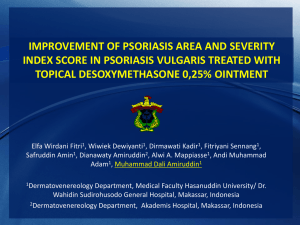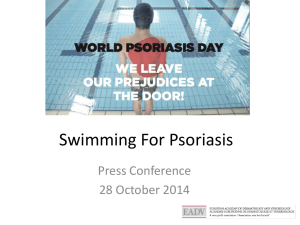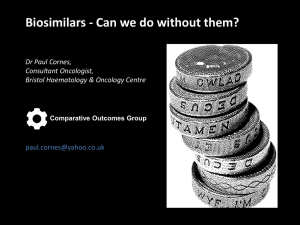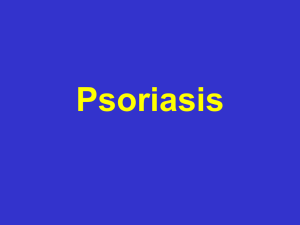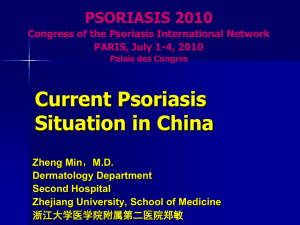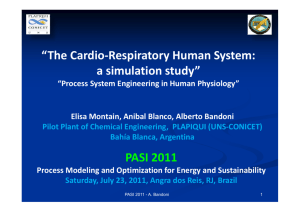Efalizumab and etanercept for the treatment of plaque psoriasis
advertisement
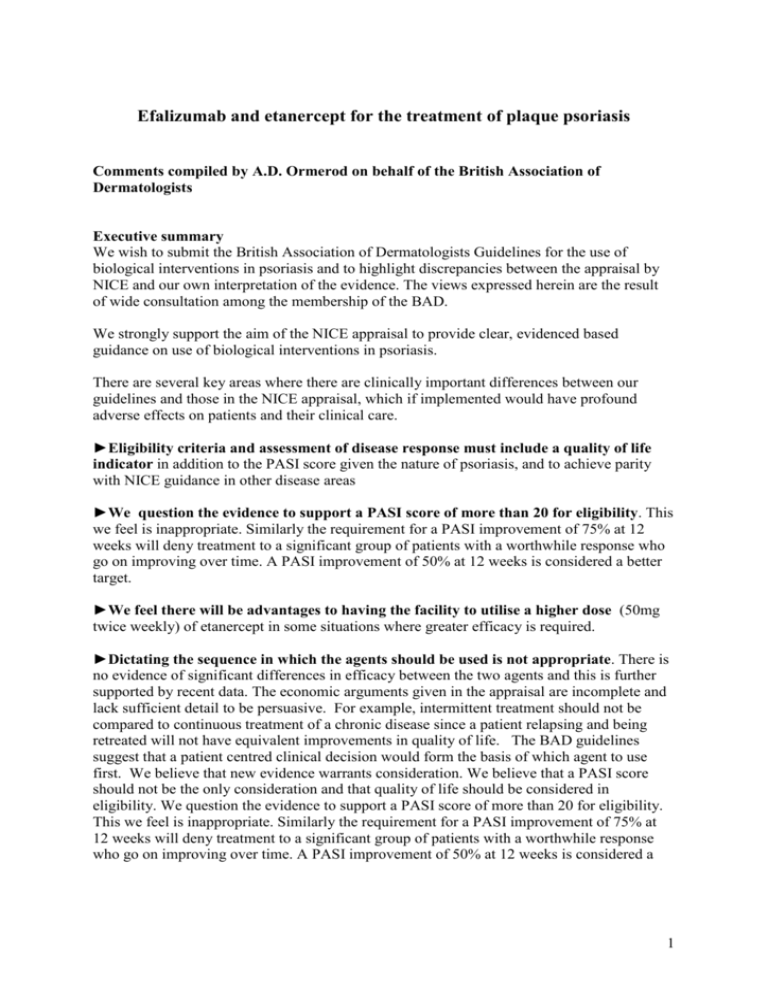
Efalizumab and etanercept for the treatment of plaque psoriasis Comments compiled by A.D. Ormerod on behalf of the British Association of Dermatologists Executive summary We wish to submit the British Association of Dermatologists Guidelines for the use of biological interventions in psoriasis and to highlight discrepancies between the appraisal by NICE and our own interpretation of the evidence. The views expressed herein are the result of wide consultation among the membership of the BAD. We strongly support the aim of the NICE appraisal to provide clear, evidenced based guidance on use of biological interventions in psoriasis. There are several key areas where there are clinically important differences between our guidelines and those in the NICE appraisal, which if implemented would have profound adverse effects on patients and their clinical care. ►Eligibility criteria and assessment of disease response must include a quality of life indicator in addition to the PASI score given the nature of psoriasis, and to achieve parity with NICE guidance in other disease areas ►We question the evidence to support a PASI score of more than 20 for eligibility. This we feel is inappropriate. Similarly the requirement for a PASI improvement of 75% at 12 weeks will deny treatment to a significant group of patients with a worthwhile response who go on improving over time. A PASI improvement of 50% at 12 weeks is considered a better target. ►We feel there will be advantages to having the facility to utilise a higher dose (50mg twice weekly) of etanercept in some situations where greater efficacy is required. ►Dictating the sequence in which the agents should be used is not appropriate. There is no evidence of significant differences in efficacy between the two agents and this is further supported by recent data. The economic arguments given in the appraisal are incomplete and lack sufficient detail to be persuasive. For example, intermittent treatment should not be compared to continuous treatment of a chronic disease since a patient relapsing and being retreated will not have equivalent improvements in quality of life. The BAD guidelines suggest that a patient centred clinical decision would form the basis of which agent to use first. We believe that new evidence warrants consideration. We believe that a PASI score should not be the only consideration and that quality of life should be considered in eligibility. We question the evidence to support a PASI score of more than 20 for eligibility. This we feel is inappropriate. Similarly the requirement for a PASI improvement of 75% at 12 weeks will deny treatment to a significant group of patients with a worthwhile response who go on improving over time. A PASI improvement of 50% at 12 weeks is considered a 1 better target. We feel there will be advantages to having the facility to utilise a higher dose (50mg twice weekly) of etanercept in situations where greater efficacy is required. Intermittent treatment should not be compared to continuous treatment of a chronic disease. A patient relapsing and being retreated will not have equivalent improvements in quality of life. This needs to be factored into the economic models. There is not evidence of significant differences in efficacy between the two agents and this is further supported by recent data. Therefore dictating the sequence in which the agents should be used is not appropriate. The economic arguments given in the appraisal are incomplete and lack sufficient detail to be persuasive. The BAD guidelines suggest that a patient centred clinical decision would form the basis of which agent to use first. Similarly our guidelines give better definition of what constitutes failure of conventional agents. 1. Whether you consider that all of the relevant evidence has been taken into account A working group of the British Association of Dermatologists has just finalised an evidence based guideline for treatment of psoriasis with rigorous methodology. This was based on clinical concerns and review of the evidence. We did not have any economic assessment as part of this process and appreciate that NICE have this highly important additional information. I will attach the final guidelines for your consideration and will highlight where the guidelines differ from your draft evaluation. We devoted a section of the guideline on how to decide which agent to use; we also included infliximab in our guideline as we feel this is also an important agent which is likely to considered in managing the same patient group. Additional trials have been published since the appraisal exercise was undertaken. These provide new evidence on the longer term use of efalizumab and on the dose response to 25mg twice weekly and 50mg twice weekly for etanercept. The following late breaking publications were considered by our working group Papp KA, Tyring SK, Lahfa M et al. A global phase III randomised controlled trial of etanercept in psoriasis: safety, efficacy, and effect of dose reduction. Br J Dermatol 2005; In press. Leonardi CL, Papp KA, Gordon KB et al. Extended efalizumab therapy improves chronic plaque psoriasis: results from a randomised phase III trial. J Am Acad Dermatol 2005; 52: 425-33. Menter A, Gordon KB, Carey W et al. Efficacy and safety observed during 24 weeks of efalizumab therapy in patients with moderate to severe plaque psoriasis. Arch Dermatol 2005; 141: 31-8. Gottlieb AB, Hamilton TK, Caro I et al. Long term continuous efalizumab therapy maintains efficacy and safety in patients with moderate to severe chronic plaque psoriasis: updated results from an ongoing trial. In press 2005. 2 Ormerod, L. P. and Joint Tuberculosis Committee of the British Thoracic Society. Recommendations for assessing risk and for managing M Tuberculosis infection and disease in adult patients due to start anti-TNF-alpha treatment. 2005 In press Kyle S, Chandler D, Griffiths C, Helliwell P, Lewis J, McInnes I, Oliver S, Symmons D, McHugh NJ. 2005. Guideline for anti-TNF treatment in psoriatic arthritis. Rheumatology. 44;390-397. Hongbo Y, Thomas CL, Harrison MA et al. Translating the science of quality of life into practice: What do Dermatology Life Quality Index scores mean? J Invest Dermatol 2005. In press Finlay AY. Current severe psoriasis and the Rule of Tens. Br J Dermatol 2005;152:861-867 Eligibility = PASI score of >20 We would strongly question the evidence for patients requiring a PASI score of >20 to be eligible for treatment. Work by Professor Finlay 1 has demonstrated that patients with a PASI score of greater than 10 are likely to be suffering severe impairment of quality of life and to be considered for drugs such as methotrexate and ciclosporin or for hospital admission. The latter was an important cost consideration in the economic assessment. Clinical trials on which the evidence for efficacy of these agents were based had a lower inclusion criterion e.g. PASI of >10 or >12. In section 4.2.3.2 the ICERs are based on patients with PASI> 10 DLQI>15. The advice therefore seems to be divergent from the evidence put forward for this assessment. Feldman suggested PASI > 11 or >10% Body Surface Area (BSA) as indicating severe disease (Journal of Investigative Dermatology 1996;106:183-186). A BSA > 10% has also been defined as having severe disease in the National Psoriasis Foundation. Facts on Psoriasis: Disease severity (2004). In section 4.2.3.2 (Page 15) PASI > 10 is referred to as having ‘relatively severe psoriasis’ – this is contradicted if you then define ‘severe’ as >20. The committee drawing up guidelines on biological interventions in psoriasis took a PASI of >10 as the threshold severity criterion for considering these new treatments. We did however, emphasise that many of these patients will already be receiving systemic therapy, albeit with poor disease control or significant adverse effects. To stop treatment in order to achieve the suggested PASI threshold of >20 would risk acute severe disease relapse with a consequent need for urgent hospitalisation. Rigid application of the >20 rule would disadvantage and possibly endanger such patients and risk increasing their overall management costs. We question why in section 1.1 the QoL measure is not used as an additional measure of severity. The correlation of PASI with impact on quality of life is poor and it is as important to consider how psoriasis affects the individual psychosocially as it is merely to consider extent of disease Some patients will be severely disadvantaged and denied treatment if the entrance requirement is set at this level and no allowance for other factors is considered. On the one hand, we would not want our guideline to imply that all otherwise eligible patients with PASI greater than 10 should be offered or would want biological interventions. 1 (Finlay AY. Current severe psoriasis and the Rule of Tens. Br J Dermatol 2005;152:861-867 and Hongbo Y, Thomas C L. Harrison M A, Salek M S, Finlay A Y. Translating the science of quality of life into practice: What do Dermatology Life Quality Index (DLQI) scores mean? JID 2005 (In press – available on request from Professor Finlay, Cardiff) 3 However, highly visible (face, hands) or symptomatic psoriasis (hands, feet, flexures and genitalia) may have an impact which is poorly reflected in the PASI score and for which quality of life scores offer a much better surrogate. Involvement of face and hands can profoundly affect the patient emotionally, functionally and economically. We feel strongly that the eligibility criteria should include an additional quality of life component. This would make the screening more rigorous and has been adopted in the BSR guidelines for rheumatoid disease. The evidence base for suggesting a PASI 75 as a required response to therapy As it is now well established that maximal improvement from both drugs may not be achieved by 12 weeks, the stipulation that PASI-75 must be achieved by 12 weeks is potentially wasting resources by forcing a treatment which will later be successful, to be abandoned inappropriately. Longer term data in the recently reported studies (above) confirm this. Further, in section 4.1.1.1 (page 9) and 4.1.1.4 (page 10) some studies extend beyond 12 weeks eg 12-24 weeks – Leonardi 2005, Lebwohl 2003. We feel a PASI- improvement of 50% by 12 weeks would be more sensible. These patients are already, by definition, hard-totreat patients. Improvement in PASI may fall short of 75% but the benefits on quality of life may still be significant and not achievable with other agents. We agree that patients who fail to achieve a reduction in PASI of 50% should discontinue treatment at the 12 week stage. The advice you give to use PASI 75 was taken from the rheumatologists’ guidelines for joint disease. These were written a few years ago for a different patient group. Our guidelines are more recent and considered the effects of these drugs on the skin rather than the joints and were formulated with the help of rheumatologists who were involved in producing the BSR guidelines. We considered the published evidence that a PASI improvement of 50% was seen by patients and physicians as a worthwhile response for patients with severe disease (Carlin CS, Feldman SR, Krueger JG et al. A 50% reduction in the Psoriasis Area and Severity Index (PASI 50) is a clinically significant endpoint in the assessment of psoriasis. J. Am. Acad. Dermatol. 2004; 859-66). Our suggested response criteria include the additional requirement that treatment should also have improved quality of life. Although quality of life issues are given emphasis in the Appraisal Committee’s pre-amble, they are not taken into account in defining either eligibility or response. We have also suggested that a PASI improvement of 50% be used prospectively to define failure of other agents. If the response criterion recommended by the Appraisal Committee were applied to standard drugs such as methotrexate and ciclosporin, then the number of patients eligible for biologicals might paradoxically increase. 4 Etanercept is restricted to use at 25mg twice weekly New data in the Papp study (above) shows a clear advantage of the 50mg dose of etanercept and we feel this should be available to for those patients who only respond suboptimally to the 25mg dose - particularly as your current recommendation would class these as treatment failures and may lead onto switching agents, repeating screening, risking a flaring of the psoriasis and further time taken to assess whether it is going to work. We feel it appropriate to restrict the higher dose but not to put it out of bounds. In section 1.1 Etanercept is also licensed for use at 50mg twice per week and there may be individual circumstances where the higher dose would be helpful. The recommendation of ‘not exceeding 25 mg twice weekly’ seems too proscriptive. 2 Whether you consider that the summaries of clinical and cost effectiveness are reasonable interpretations of the evidence and that the preliminary views on the resource impact and implications for the NHS are appropriate. The order in which treatments should be used We question the evidence that underpins the recommendation that etanercept must be used before efalizumab - there is more data coming into the public domain showing longer term efficacy and safety of efalizumab. For example Menter (above) showing PASI 75% improvement in 26% at 12 weeks and in 44% at 24 weeks with efalizumab, Leonardi (above) showing PASI 75% improvement in 39% at 12 weeks. In the absence of any scientific evidence base for differences in efficacy or safety, clinical judgement should direct the order in which therapies be used. Was this decision based on cost models as there are no comparative trials? It appears to have been based on the assessment group’s economic modelling for intermittent treatment, which can only apply to etanercept. It is not clear whether the ICER model took account of the less constant control that would occur with intermittent treatment. It is reasonable to assume that among high need patients the disease would undergo repeated exacerbations and these would each take 12-24 weeks to respond - a less costly but also less effective scenario over 1 year. Sensitivity analysis of the economic models should factor in the possibility that intermittent treatment over 12 months might produce only 50% of the qualy that continuous treatment might. In 4.3.5 you state “ efalizumab and etanercept continuous were dominated by intermittent etanercept”. We are not convinced that it is fair to compare continuous and intermittent treatment. A cost comparison of continuous efalizumab against continuous etanercept needs to be quoted but has been missed in this evaluation. Likewise the ICERS for efalizumab in patients with severe disease at risk of admission are not given in section 4.2.4.2, so it is not possible for the reader to evaluate any basis for the economic conclusions. Section 4.3.5 gives the criteria for efalizumab as “failed to respond to or … intolerant of etanercept” while section 7.3.2 has “or has a contra-indication to etanercept”. There is a difference between being intolerant and having a contra-indication. These sections should be consistent, if etanercept were to remain the favoured agent after the considerations above. 5 If this is the first instance in which NICE has prescribed the order in which drugs have to be used, there needs to be a better evidence base than that presented in this assessment. 3 Whether you consider that the provisional recommendations of the Appraisal Committee are sound and constitute a suitable basis for the preparation of guidance to the NHS. There is much to commend in the appraisal particularly that the importance of psoriasis as a clinical need is acknowledged and the need for both treatments to be recognised, as they will benefit different patients and have distinct modes of action. We appreciate the significant costs of these treatments and a need to restrict their use to the most needy patients and also the need for pharmacovigilance. We are taking steps to set up a register which we hope will be established not far behind the final appraisal from NICE. We recognise that the consultation period should enhance the appraisal and with further consideration of stakeholder comments this will be a suitable basis for guidance. 4 Additional comments on the evaluation report. Major points 1. Eligibility The wording in Section 1.a of Appendix C (audit criteria), if interpreted as written, is extremely restrictive. As it stands a patient would have had to have tried and failed “all other systemic therapy in routine use” or to be intolerant or have a contraindication to “all other systemic therapy in routine use”. As worded, a patient who had a contraindication to one systemic therapy but had failed all the others would not qualify. The second “all” does not appear in sections 1.1 and 1.2. The definition of standard therapy and of its failure or contra-indication is covered on page 5 of our guideline with greater clarity. The drugs that must have been used require much clearer instructions. “All other systemic therapy in routine use including ciclosporin, methotrexate and PUVA” is confusing as there are many agents that are non-standard or not licensed such as hydroxycarbamide and fumarates. We worked hard to define eligibilty. Specifically, in our guideline, we define standard treatment as acitretin, ciclosporin, methotrexate, narrow band UVB and psoralen photochemotherapy (PUVA). We then stipulate that the patients should fulfil at least one of the following clinical categories: (i) have developed or are at higher than average risk of developing clinically important drug-related toxicity and where alternative standard therapy cannot be used 6 (ii) are or have become intolerant to or cannot receive standard systemic therapy (iii) are or have become unresponsive to standard therapy (iv) have disease that is only controlled by repeated in-patient management (v) have significant, coexistent, unrelated co-morbidity which precludes use of systemic agents such as ciclosporin or methotrexate (vi) have severe, unstable, life-threatening disease (erythrodermic or pustular psoriasis) (vii) have psoriatic arthritis fulfilling the British Society of Rheumatology (BSR) eligibility criteria for treatment with anti-TNF11, in association with skin disease We define being unresponsive to standard treatment as: an unsatisfactory clinical response (a less than 50% improvement in baseline PASI score or % body surface area where the PASI is not applicable, and 5 point improvement in DLQI) to at least 3 months treatment in the therapeutic dose range to the following treatments : ciclosporin: 2.5 mg/kg/day; up to 5 mg/kg/day methotrexate single weekly dose (PO, SC, IM) at 15 mg/wk; max 25–30 mg/wk acitretin: 25–50 mg daily narrow band UVB or psoralen photochemotherapy (non response, rapid relapse or exceeding recommended maximum doses: 150-200 treatments for PUVA, 350 treatments for narrow band UVB. We suggest that NICE consider adopting these better defined criteria or refer to our guideline for the detailed criteria. 2. Some members feel that PASI scoring is too difficult to learn or time consuming. It is not ideal as it is a non-linear scale, with area being difficult to accurately estimate (large inter-observer variations occur). However, the guideline development group felt that an objective score of efficacy was essential to build into the registration process and to monitor outcomes in a meaningful way and that PASI would enable results to be compared with trials, the literature and between agents. Rheumatologists were similarly wary of DAS scores for arthritis but this became established practice and nurses were trained to make the relevant observations. Patients with Crohn’s disease similarly have validated severity indices CDAI on which to base therapy. We feel that despite its known deficiencies PASI scoring should be carried out and measured as part of patient monitoring. Our guideline can be supported by paper or excel worksheets that facilitate the calculation of PASI score and a program of nurse education. 7 3. Use in Children Although not licensed in children there is concern that we will be able to continue to use etanercept when appropriate in children with psoriasis. Etanercept is used by rheumatologists for children with Juvenile RA and has been used at Great Ormond Street in very occasional children with severe psoriasis unresponsive to methotrexate. These cases are rare but we feel it would be reasonable to advise that (1) etanercept is the favoured product at this stage as there is greater experience with it in children in general and (2) the drug be initiated by special centres with experience of treatment of children. Alternatively it could be acknowledged that the use in children was out-with the scope of this appraisal and that recommendations were not made perhaps making the case for more clinical trials in children on which to base recommendations. 4. Economic considerations In section 6. 2.12 (page 6) in assessing the costs of alternative therapies you may find useful information from a poster presented at the EADV, Prague 2002 by Piercy et al. ‘Estimating the cost of moderate to severe chronic plaque psoriasis in the UK.’. Briefly, annual cost of systemic treatment: acitretin £411,545; cyclosporin £10,151,526; methotrexate £1,485,007; phototherapy (UVB/PUVA) £14,956,500; inpatient £8,983,200. 5. Tuberculosis risk We have worked with the British Thoracic Association who have guidelines specific to reducing the risk of tuberculosis and developed an algorithm for the stratification of risk which includes skin testing those who are not immunosuppressed already and differential responses depending on prior exposure to BCG vaccination. We obviously recommend that these precautions be taken. Minor points 1. In section 2.2 (page 3), drugs should be included as an aggravating cause of psoriasis 2. In section 7. 4.1.1.1 (page 9), doses of 1-2 mg/kg/wk used in studies by Leonardi 2005 and Lebwohl 2003. (There being no significant difference between the doses) 3. The remit of the Appraisal Committee is set out in the preamble to the Appraisal Consultation Document (ACD): The Department of Health and the National Assembly for Wales have asked the National Institute for Health and Clinical Excellence (NICE or the Institute) to conduct an appraisal of efalizumab and etanercept for the treatment of psoriasis and provide guidance on its use to the NHS in 8 England and Wales. This does not restrict it to plaque psoriasis and this seems to have crept into the title, recommendations and audit criteria (Appendix C) without justification in the ACD. Section 2 (Clinical Need and Practice), by contrast, refers only to psoriasis, not to plaque psoriasis. 9

